Organizational Change and Development at VIRSIS
VerifiedAdded on 2021/04/23
|8
|2226
|231
AI Summary
The assignment provided is focused on addressing the problems faced by VIRSIS, including high employee turnover, poor management practices, low employee morale, and competitive advantage. The recommended solution involves adopting a new organizational culture and participatory managerial style, as well as an effective human resources approach to rebuilding relationships between leadership and workers. The implementation plan includes consulting with an organizational development consultant, setting up a Human Resources department, and selling the upcoming changes to employees.
Contribute Materials
Your contribution can guide someone’s learning journey. Share your
documents today.
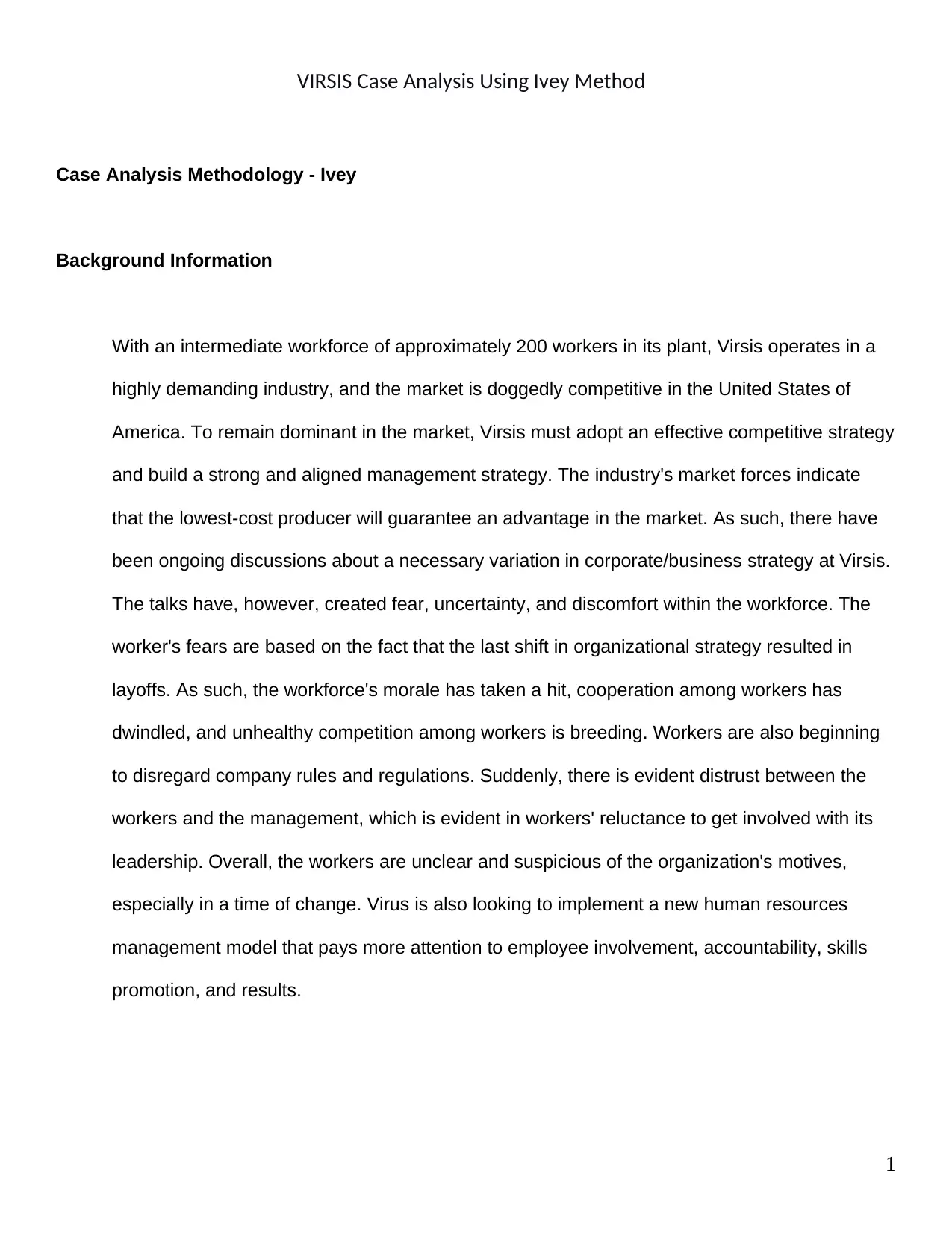
VIRSIS Case Analysis Using Ivey Method
Case Analysis Methodology - Ivey
Background Information
With an intermediate workforce of approximately 200 workers in its plant, Virsis operates in a
highly demanding industry, and the market is doggedly competitive in the United States of
America. To remain dominant in the market, Virsis must adopt an effective competitive strategy
and build a strong and aligned management strategy. The industry's market forces indicate
that the lowest-cost producer will guarantee an advantage in the market. As such, there have
been ongoing discussions about a necessary variation in corporate/business strategy at Virsis.
The talks have, however, created fear, uncertainty, and discomfort within the workforce. The
worker's fears are based on the fact that the last shift in organizational strategy resulted in
layoffs. As such, the workforce's morale has taken a hit, cooperation among workers has
dwindled, and unhealthy competition among workers is breeding. Workers are also beginning
to disregard company rules and regulations. Suddenly, there is evident distrust between the
workers and the management, which is evident in workers' reluctance to get involved with its
leadership. Overall, the workers are unclear and suspicious of the organization's motives,
especially in a time of change. Virus is also looking to implement a new human resources
management model that pays more attention to employee involvement, accountability, skills
promotion, and results.
1
Case Analysis Methodology - Ivey
Background Information
With an intermediate workforce of approximately 200 workers in its plant, Virsis operates in a
highly demanding industry, and the market is doggedly competitive in the United States of
America. To remain dominant in the market, Virsis must adopt an effective competitive strategy
and build a strong and aligned management strategy. The industry's market forces indicate
that the lowest-cost producer will guarantee an advantage in the market. As such, there have
been ongoing discussions about a necessary variation in corporate/business strategy at Virsis.
The talks have, however, created fear, uncertainty, and discomfort within the workforce. The
worker's fears are based on the fact that the last shift in organizational strategy resulted in
layoffs. As such, the workforce's morale has taken a hit, cooperation among workers has
dwindled, and unhealthy competition among workers is breeding. Workers are also beginning
to disregard company rules and regulations. Suddenly, there is evident distrust between the
workers and the management, which is evident in workers' reluctance to get involved with its
leadership. Overall, the workers are unclear and suspicious of the organization's motives,
especially in a time of change. Virus is also looking to implement a new human resources
management model that pays more attention to employee involvement, accountability, skills
promotion, and results.
1
Secure Best Marks with AI Grader
Need help grading? Try our AI Grader for instant feedback on your assignments.
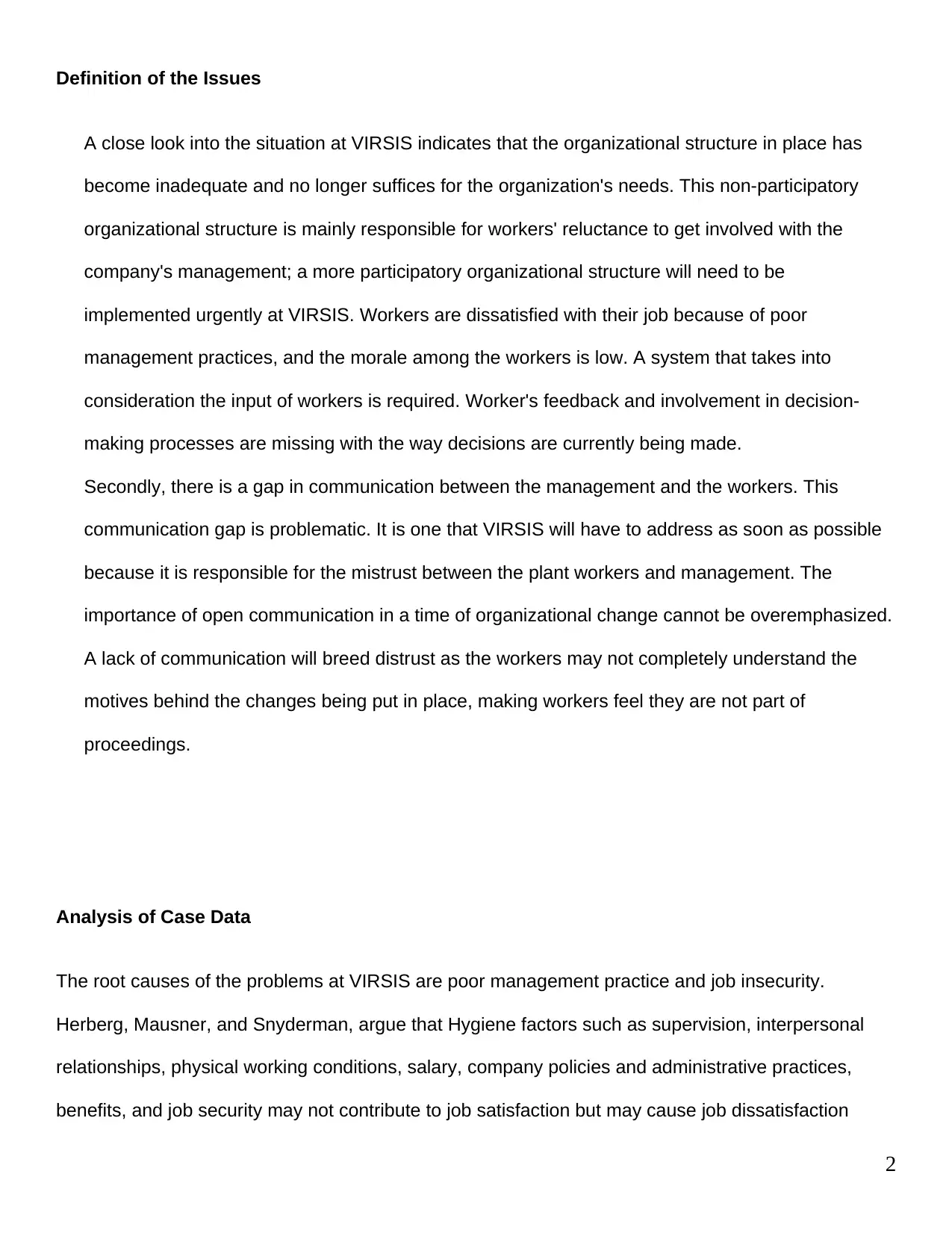
Definition of the Issues
A close look into the situation at VIRSIS indicates that the organizational structure in place has
become inadequate and no longer suffices for the organization's needs. This non-participatory
organizational structure is mainly responsible for workers' reluctance to get involved with the
company's management; a more participatory organizational structure will need to be
implemented urgently at VIRSIS. Workers are dissatisfied with their job because of poor
management practices, and the morale among the workers is low. A system that takes into
consideration the input of workers is required. Worker's feedback and involvement in decision-
making processes are missing with the way decisions are currently being made.
Secondly, there is a gap in communication between the management and the workers. This
communication gap is problematic. It is one that VIRSIS will have to address as soon as possible
because it is responsible for the mistrust between the plant workers and management. The
importance of open communication in a time of organizational change cannot be overemphasized.
A lack of communication will breed distrust as the workers may not completely understand the
motives behind the changes being put in place, making workers feel they are not part of
proceedings.
Analysis of Case Data
The root causes of the problems at VIRSIS are poor management practice and job insecurity.
Herberg, Mausner, and Snyderman, argue that Hygiene factors such as supervision, interpersonal
relationships, physical working conditions, salary, company policies and administrative practices,
benefits, and job security may not contribute to job satisfaction but may cause job dissatisfaction
2
A close look into the situation at VIRSIS indicates that the organizational structure in place has
become inadequate and no longer suffices for the organization's needs. This non-participatory
organizational structure is mainly responsible for workers' reluctance to get involved with the
company's management; a more participatory organizational structure will need to be
implemented urgently at VIRSIS. Workers are dissatisfied with their job because of poor
management practices, and the morale among the workers is low. A system that takes into
consideration the input of workers is required. Worker's feedback and involvement in decision-
making processes are missing with the way decisions are currently being made.
Secondly, there is a gap in communication between the management and the workers. This
communication gap is problematic. It is one that VIRSIS will have to address as soon as possible
because it is responsible for the mistrust between the plant workers and management. The
importance of open communication in a time of organizational change cannot be overemphasized.
A lack of communication will breed distrust as the workers may not completely understand the
motives behind the changes being put in place, making workers feel they are not part of
proceedings.
Analysis of Case Data
The root causes of the problems at VIRSIS are poor management practice and job insecurity.
Herberg, Mausner, and Snyderman, argue that Hygiene factors such as supervision, interpersonal
relationships, physical working conditions, salary, company policies and administrative practices,
benefits, and job security may not contribute to job satisfaction but may cause job dissatisfaction
2
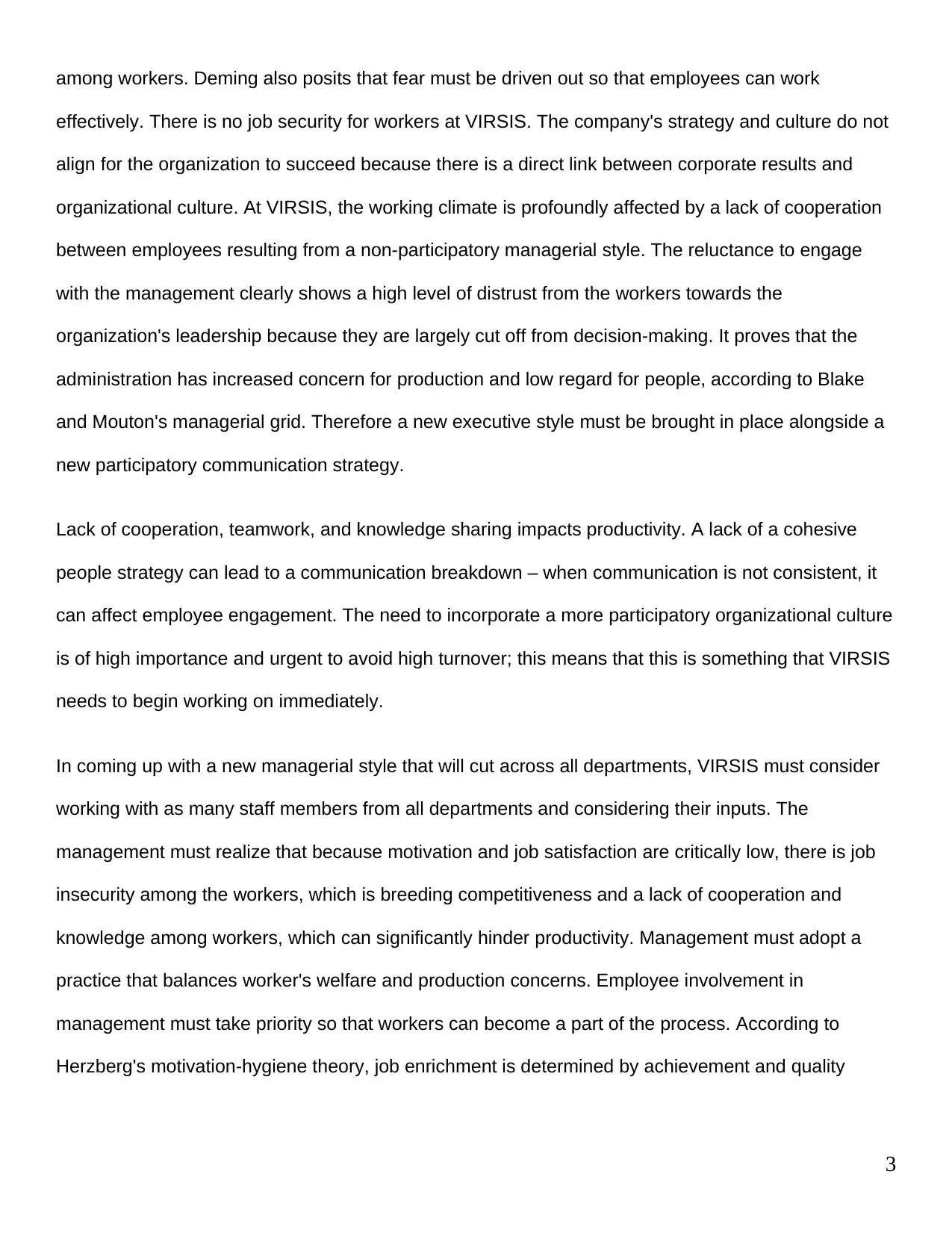
among workers. Deming also posits that fear must be driven out so that employees can work
effectively. There is no job security for workers at VIRSIS. The company's strategy and culture do not
align for the organization to succeed because there is a direct link between corporate results and
organizational culture. At VIRSIS, the working climate is profoundly affected by a lack of cooperation
between employees resulting from a non-participatory managerial style. The reluctance to engage
with the management clearly shows a high level of distrust from the workers towards the
organization's leadership because they are largely cut off from decision-making. It proves that the
administration has increased concern for production and low regard for people, according to Blake
and Mouton's managerial grid. Therefore a new executive style must be brought in place alongside a
new participatory communication strategy.
Lack of cooperation, teamwork, and knowledge sharing impacts productivity. A lack of a cohesive
people strategy can lead to a communication breakdown – when communication is not consistent, it
can affect employee engagement. The need to incorporate a more participatory organizational culture
is of high importance and urgent to avoid high turnover; this means that this is something that VIRSIS
needs to begin working on immediately.
In coming up with a new managerial style that will cut across all departments, VIRSIS must consider
working with as many staff members from all departments and considering their inputs. The
management must realize that because motivation and job satisfaction are critically low, there is job
insecurity among the workers, which is breeding competitiveness and a lack of cooperation and
knowledge among workers, which can significantly hinder productivity. Management must adopt a
practice that balances worker's welfare and production concerns. Employee involvement in
management must take priority so that workers can become a part of the process. According to
Herzberg's motivation-hygiene theory, job enrichment is determined by achievement and quality
3
effectively. There is no job security for workers at VIRSIS. The company's strategy and culture do not
align for the organization to succeed because there is a direct link between corporate results and
organizational culture. At VIRSIS, the working climate is profoundly affected by a lack of cooperation
between employees resulting from a non-participatory managerial style. The reluctance to engage
with the management clearly shows a high level of distrust from the workers towards the
organization's leadership because they are largely cut off from decision-making. It proves that the
administration has increased concern for production and low regard for people, according to Blake
and Mouton's managerial grid. Therefore a new executive style must be brought in place alongside a
new participatory communication strategy.
Lack of cooperation, teamwork, and knowledge sharing impacts productivity. A lack of a cohesive
people strategy can lead to a communication breakdown – when communication is not consistent, it
can affect employee engagement. The need to incorporate a more participatory organizational culture
is of high importance and urgent to avoid high turnover; this means that this is something that VIRSIS
needs to begin working on immediately.
In coming up with a new managerial style that will cut across all departments, VIRSIS must consider
working with as many staff members from all departments and considering their inputs. The
management must realize that because motivation and job satisfaction are critically low, there is job
insecurity among the workers, which is breeding competitiveness and a lack of cooperation and
knowledge among workers, which can significantly hinder productivity. Management must adopt a
practice that balances worker's welfare and production concerns. Employee involvement in
management must take priority so that workers can become a part of the process. According to
Herzberg's motivation-hygiene theory, job enrichment is determined by achievement and quality
3
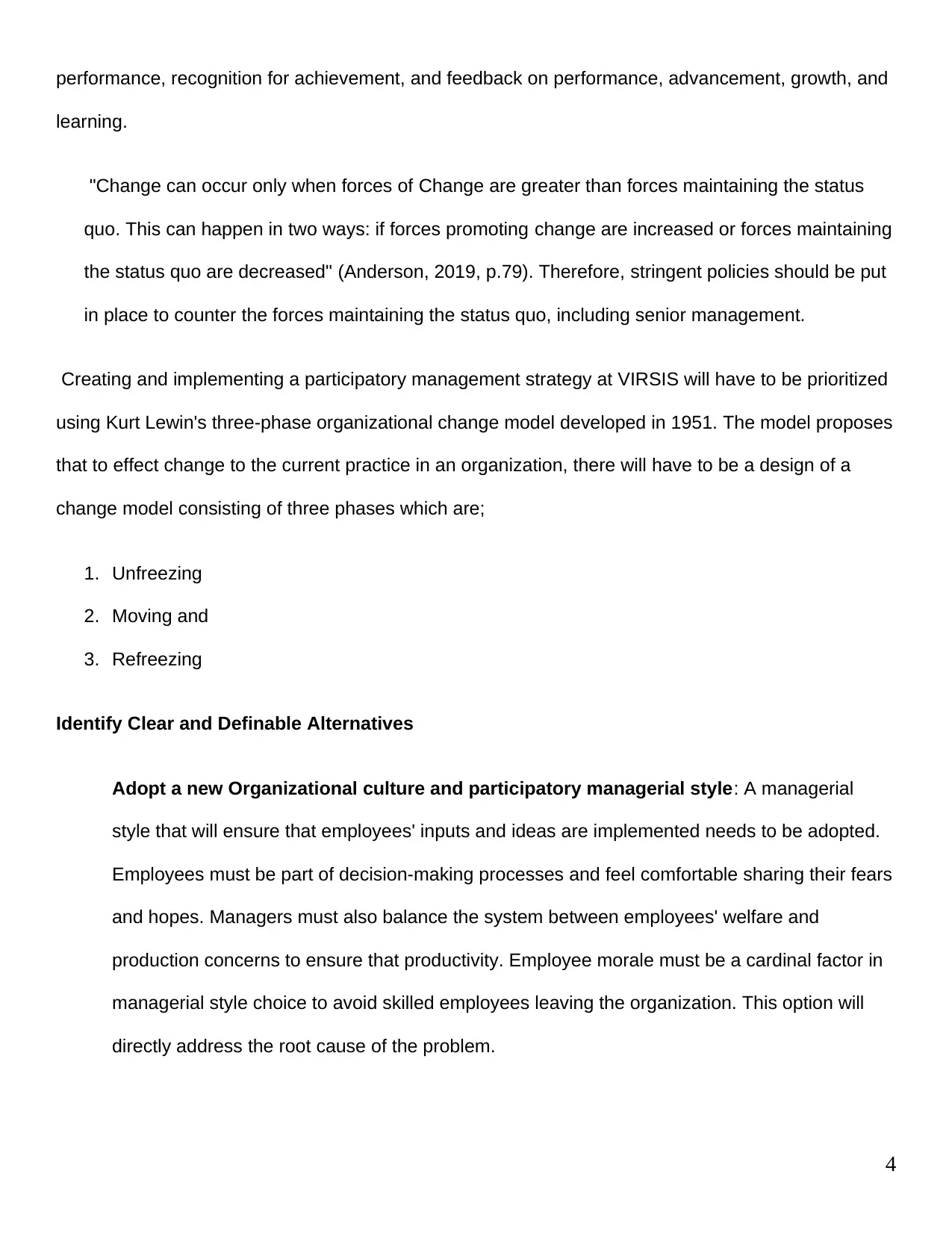
performance, recognition for achievement, and feedback on performance, advancement, growth, and
learning.
"Change can occur only when forces of Change are greater than forces maintaining the status
quo. This can happen in two ways: if forces promoting change are increased or forces maintaining
the status quo are decreased" (Anderson, 2019, p.79). Therefore, stringent policies should be put
in place to counter the forces maintaining the status quo, including senior management.
Creating and implementing a participatory management strategy at VIRSIS will have to be prioritized
using Kurt Lewin's three-phase organizational change model developed in 1951. The model proposes
that to effect change to the current practice in an organization, there will have to be a design of a
change model consisting of three phases which are;
1. Unfreezing
2. Moving and
3. Refreezing
Identify Clear and Definable Alternatives
Adopt a new Organizational culture and participatory managerial style: A managerial
style that will ensure that employees' inputs and ideas are implemented needs to be adopted.
Employees must be part of decision-making processes and feel comfortable sharing their fears
and hopes. Managers must also balance the system between employees' welfare and
production concerns to ensure that productivity. Employee morale must be a cardinal factor in
managerial style choice to avoid skilled employees leaving the organization. This option will
directly address the root cause of the problem.
4
learning.
"Change can occur only when forces of Change are greater than forces maintaining the status
quo. This can happen in two ways: if forces promoting change are increased or forces maintaining
the status quo are decreased" (Anderson, 2019, p.79). Therefore, stringent policies should be put
in place to counter the forces maintaining the status quo, including senior management.
Creating and implementing a participatory management strategy at VIRSIS will have to be prioritized
using Kurt Lewin's three-phase organizational change model developed in 1951. The model proposes
that to effect change to the current practice in an organization, there will have to be a design of a
change model consisting of three phases which are;
1. Unfreezing
2. Moving and
3. Refreezing
Identify Clear and Definable Alternatives
Adopt a new Organizational culture and participatory managerial style: A managerial
style that will ensure that employees' inputs and ideas are implemented needs to be adopted.
Employees must be part of decision-making processes and feel comfortable sharing their fears
and hopes. Managers must also balance the system between employees' welfare and
production concerns to ensure that productivity. Employee morale must be a cardinal factor in
managerial style choice to avoid skilled employees leaving the organization. This option will
directly address the root cause of the problem.
4
Secure Best Marks with AI Grader
Need help grading? Try our AI Grader for instant feedback on your assignments.
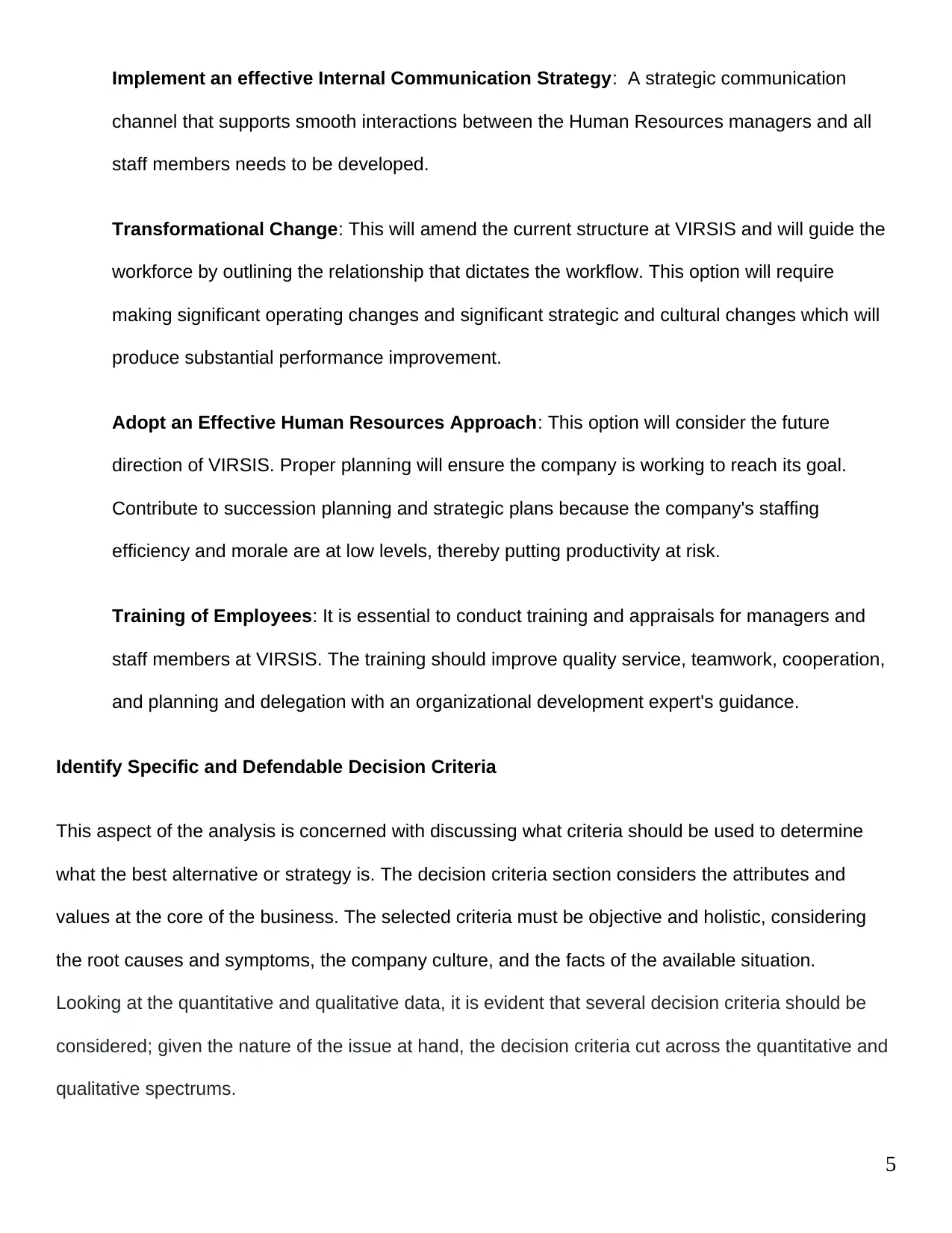
Implement an effective Internal Communication Strategy: A strategic communication
channel that supports smooth interactions between the Human Resources managers and all
staff members needs to be developed.
Transformational Change: This will amend the current structure at VIRSIS and will guide the
workforce by outlining the relationship that dictates the workflow. This option will require
making significant operating changes and significant strategic and cultural changes which will
produce substantial performance improvement.
Adopt an Effective Human Resources Approach: This option will consider the future
direction of VIRSIS. Proper planning will ensure the company is working to reach its goal.
Contribute to succession planning and strategic plans because the company's staffing
efficiency and morale are at low levels, thereby putting productivity at risk.
Training of Employees: It is essential to conduct training and appraisals for managers and
staff members at VIRSIS. The training should improve quality service, teamwork, cooperation,
and planning and delegation with an organizational development expert's guidance.
Identify Specific and Defendable Decision Criteria
This aspect of the analysis is concerned with discussing what criteria should be used to determine
what the best alternative or strategy is. The decision criteria section considers the attributes and
values at the core of the business. The selected criteria must be objective and holistic, considering
the root causes and symptoms, the company culture, and the facts of the available situation.
Looking at the quantitative and qualitative data, it is evident that several decision criteria should be
considered; given the nature of the issue at hand, the decision criteria cut across the quantitative and
qualitative spectrums.
5
channel that supports smooth interactions between the Human Resources managers and all
staff members needs to be developed.
Transformational Change: This will amend the current structure at VIRSIS and will guide the
workforce by outlining the relationship that dictates the workflow. This option will require
making significant operating changes and significant strategic and cultural changes which will
produce substantial performance improvement.
Adopt an Effective Human Resources Approach: This option will consider the future
direction of VIRSIS. Proper planning will ensure the company is working to reach its goal.
Contribute to succession planning and strategic plans because the company's staffing
efficiency and morale are at low levels, thereby putting productivity at risk.
Training of Employees: It is essential to conduct training and appraisals for managers and
staff members at VIRSIS. The training should improve quality service, teamwork, cooperation,
and planning and delegation with an organizational development expert's guidance.
Identify Specific and Defendable Decision Criteria
This aspect of the analysis is concerned with discussing what criteria should be used to determine
what the best alternative or strategy is. The decision criteria section considers the attributes and
values at the core of the business. The selected criteria must be objective and holistic, considering
the root causes and symptoms, the company culture, and the facts of the available situation.
Looking at the quantitative and qualitative data, it is evident that several decision criteria should be
considered; given the nature of the issue at hand, the decision criteria cut across the quantitative and
qualitative spectrums.
5
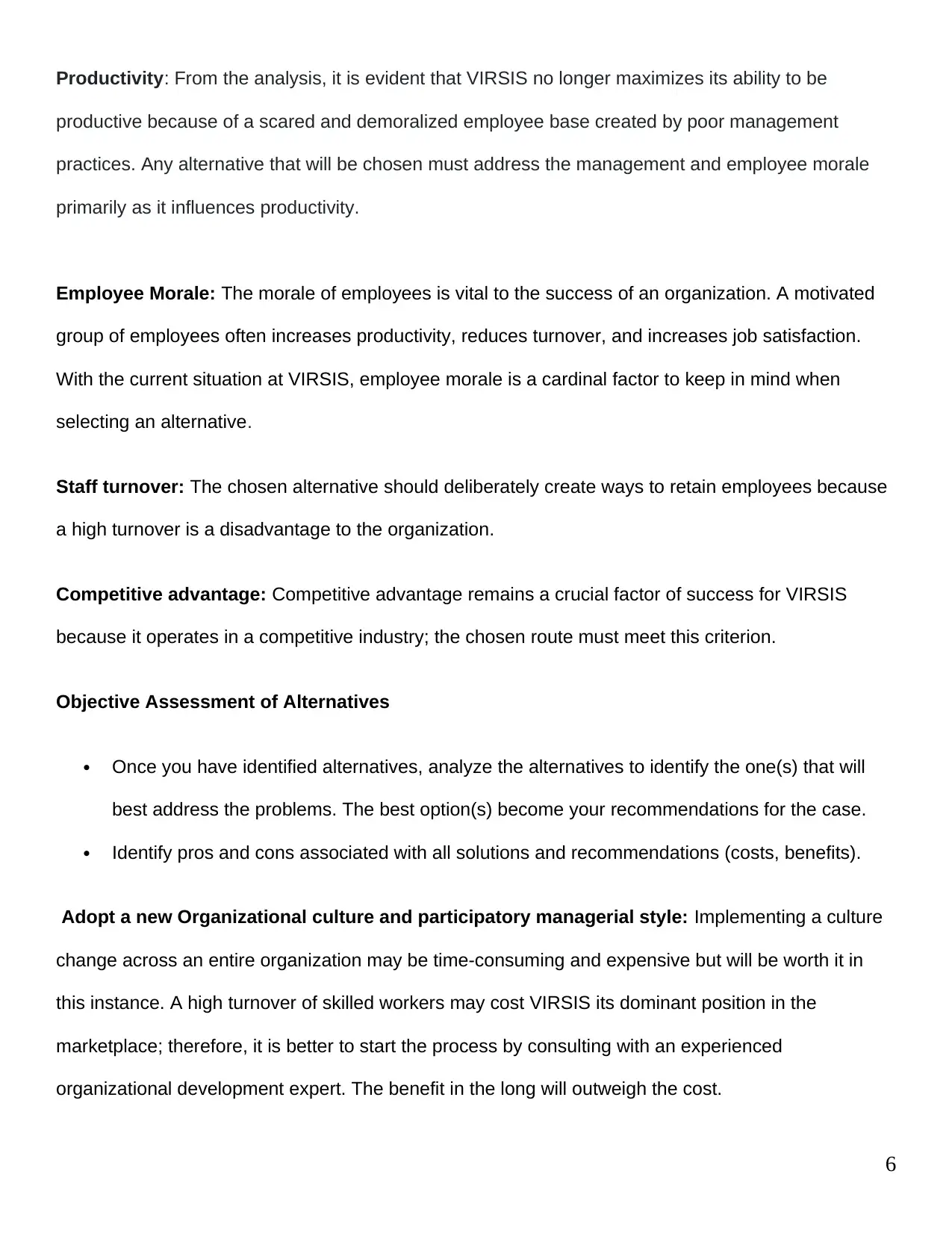
Productivity: From the analysis, it is evident that VIRSIS no longer maximizes its ability to be
productive because of a scared and demoralized employee base created by poor management
practices. Any alternative that will be chosen must address the management and employee morale
primarily as it influences productivity.
Employee Morale: The morale of employees is vital to the success of an organization. A motivated
group of employees often increases productivity, reduces turnover, and increases job satisfaction.
With the current situation at VIRSIS, employee morale is a cardinal factor to keep in mind when
selecting an alternative.
Staff turnover: The chosen alternative should deliberately create ways to retain employees because
a high turnover is a disadvantage to the organization.
Competitive advantage: Competitive advantage remains a crucial factor of success for VIRSIS
because it operates in a competitive industry; the chosen route must meet this criterion.
Objective Assessment of Alternatives
Once you have identified alternatives, analyze the alternatives to identify the one(s) that will
best address the problems. The best option(s) become your recommendations for the case.
Identify pros and cons associated with all solutions and recommendations (costs, benefits).
Adopt a new Organizational culture and participatory managerial style: Implementing a culture
change across an entire organization may be time-consuming and expensive but will be worth it in
this instance. A high turnover of skilled workers may cost VIRSIS its dominant position in the
marketplace; therefore, it is better to start the process by consulting with an experienced
organizational development expert. The benefit in the long will outweigh the cost.
6
productive because of a scared and demoralized employee base created by poor management
practices. Any alternative that will be chosen must address the management and employee morale
primarily as it influences productivity.
Employee Morale: The morale of employees is vital to the success of an organization. A motivated
group of employees often increases productivity, reduces turnover, and increases job satisfaction.
With the current situation at VIRSIS, employee morale is a cardinal factor to keep in mind when
selecting an alternative.
Staff turnover: The chosen alternative should deliberately create ways to retain employees because
a high turnover is a disadvantage to the organization.
Competitive advantage: Competitive advantage remains a crucial factor of success for VIRSIS
because it operates in a competitive industry; the chosen route must meet this criterion.
Objective Assessment of Alternatives
Once you have identified alternatives, analyze the alternatives to identify the one(s) that will
best address the problems. The best option(s) become your recommendations for the case.
Identify pros and cons associated with all solutions and recommendations (costs, benefits).
Adopt a new Organizational culture and participatory managerial style: Implementing a culture
change across an entire organization may be time-consuming and expensive but will be worth it in
this instance. A high turnover of skilled workers may cost VIRSIS its dominant position in the
marketplace; therefore, it is better to start the process by consulting with an experienced
organizational development expert. The benefit in the long will outweigh the cost.
6
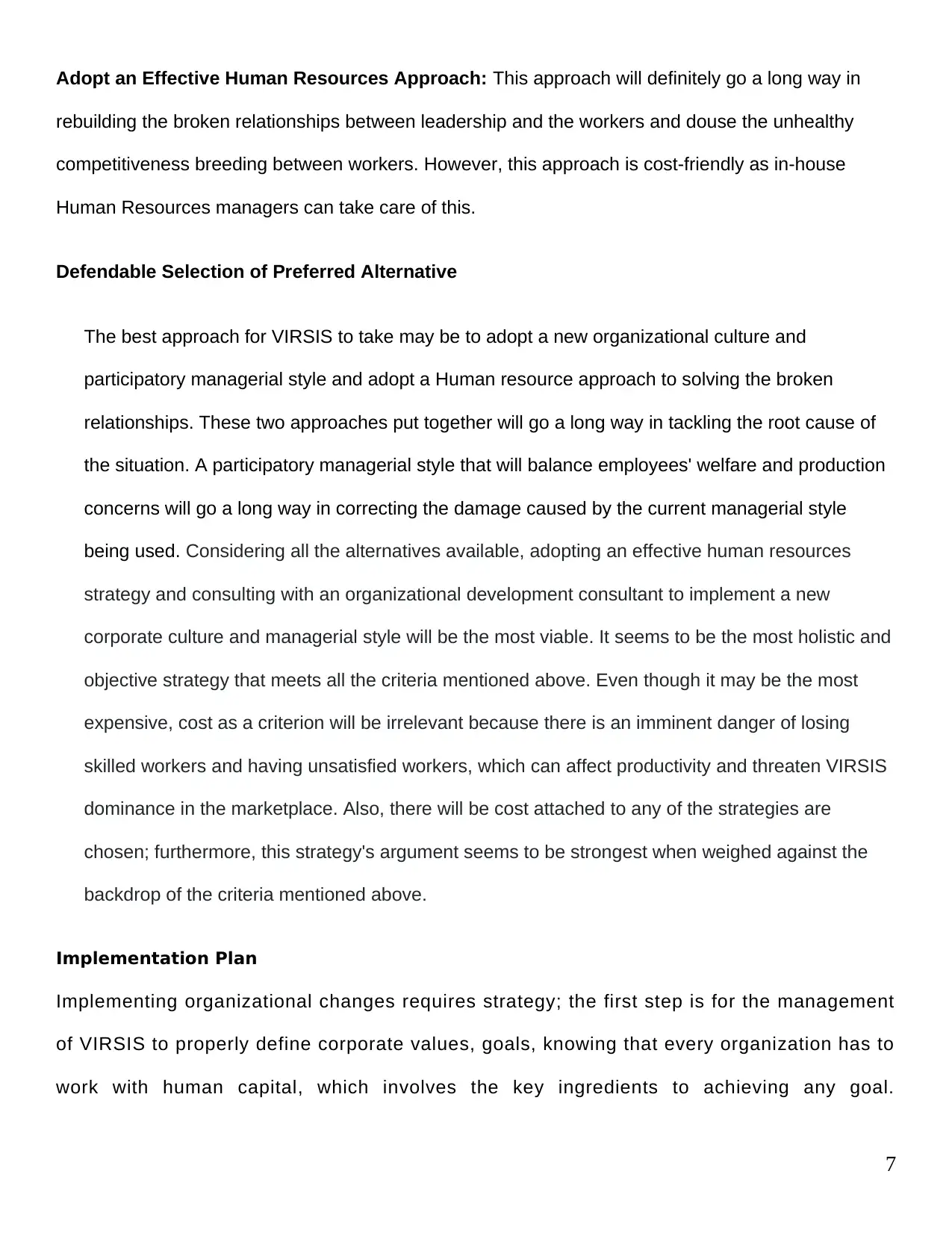
Adopt an Effective Human Resources Approach: This approach will definitely go a long way in
rebuilding the broken relationships between leadership and the workers and douse the unhealthy
competitiveness breeding between workers. However, this approach is cost-friendly as in-house
Human Resources managers can take care of this.
Defendable Selection of Preferred Alternative
The best approach for VIRSIS to take may be to adopt a new organizational culture and
participatory managerial style and adopt a Human resource approach to solving the broken
relationships. These two approaches put together will go a long way in tackling the root cause of
the situation. A participatory managerial style that will balance employees' welfare and production
concerns will go a long way in correcting the damage caused by the current managerial style
being used. Considering all the alternatives available, adopting an effective human resources
strategy and consulting with an organizational development consultant to implement a new
corporate culture and managerial style will be the most viable. It seems to be the most holistic and
objective strategy that meets all the criteria mentioned above. Even though it may be the most
expensive, cost as a criterion will be irrelevant because there is an imminent danger of losing
skilled workers and having unsatisfied workers, which can affect productivity and threaten VIRSIS
dominance in the marketplace. Also, there will be cost attached to any of the strategies are
chosen; furthermore, this strategy's argument seems to be strongest when weighed against the
backdrop of the criteria mentioned above.
Implementation Plan
Implementing organizational changes requires strategy; the first step is for the management
of VIRSIS to properly define corporate values, goals, knowing that every organization has to
work with human capital, which involves the key ingredients to achieving any goal.
7
rebuilding the broken relationships between leadership and the workers and douse the unhealthy
competitiveness breeding between workers. However, this approach is cost-friendly as in-house
Human Resources managers can take care of this.
Defendable Selection of Preferred Alternative
The best approach for VIRSIS to take may be to adopt a new organizational culture and
participatory managerial style and adopt a Human resource approach to solving the broken
relationships. These two approaches put together will go a long way in tackling the root cause of
the situation. A participatory managerial style that will balance employees' welfare and production
concerns will go a long way in correcting the damage caused by the current managerial style
being used. Considering all the alternatives available, adopting an effective human resources
strategy and consulting with an organizational development consultant to implement a new
corporate culture and managerial style will be the most viable. It seems to be the most holistic and
objective strategy that meets all the criteria mentioned above. Even though it may be the most
expensive, cost as a criterion will be irrelevant because there is an imminent danger of losing
skilled workers and having unsatisfied workers, which can affect productivity and threaten VIRSIS
dominance in the marketplace. Also, there will be cost attached to any of the strategies are
chosen; furthermore, this strategy's argument seems to be strongest when weighed against the
backdrop of the criteria mentioned above.
Implementation Plan
Implementing organizational changes requires strategy; the first step is for the management
of VIRSIS to properly define corporate values, goals, knowing that every organization has to
work with human capital, which involves the key ingredients to achieving any goal.
7
Paraphrase This Document
Need a fresh take? Get an instant paraphrase of this document with our AI Paraphraser
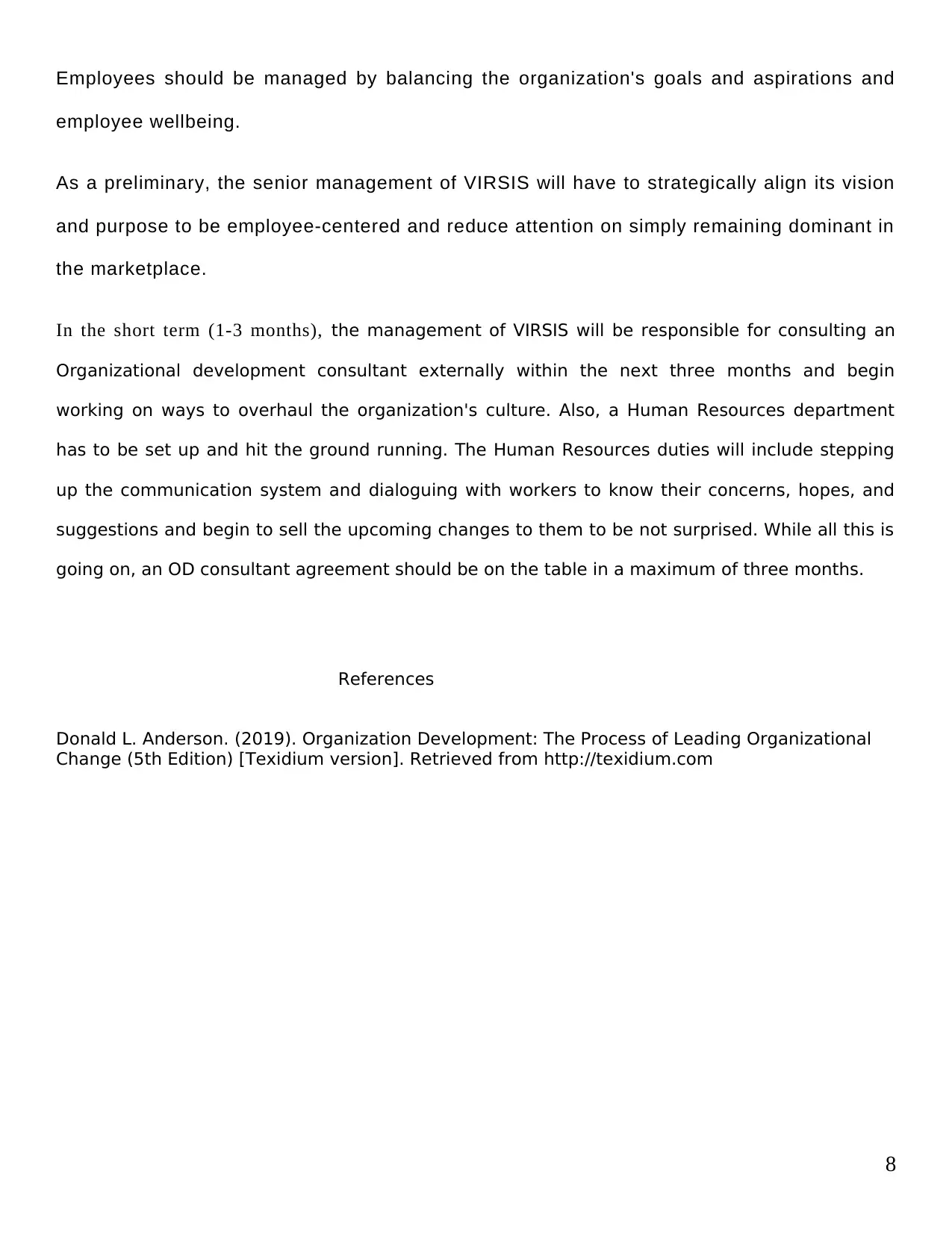
Employees should be managed by balancing the organization's goals and aspirations and
employee wellbeing.
As a preliminary, the senior management of VIRSIS will have to strategically align its vision
and purpose to be employee-centered and reduce attention on simply remaining dominant in
the marketplace.
In the short term (1-3 months), the management of VIRSIS will be responsible for consulting an
Organizational development consultant externally within the next three months and begin
working on ways to overhaul the organization's culture. Also, a Human Resources department
has to be set up and hit the ground running. The Human Resources duties will include stepping
up the communication system and dialoguing with workers to know their concerns, hopes, and
suggestions and begin to sell the upcoming changes to them to be not surprised. While all this is
going on, an OD consultant agreement should be on the table in a maximum of three months.
References
Donald L. Anderson. (2019). Organization Development: The Process of Leading Organizational
Change (5th Edition) [Texidium version]. Retrieved from http://texidium.com
8
employee wellbeing.
As a preliminary, the senior management of VIRSIS will have to strategically align its vision
and purpose to be employee-centered and reduce attention on simply remaining dominant in
the marketplace.
In the short term (1-3 months), the management of VIRSIS will be responsible for consulting an
Organizational development consultant externally within the next three months and begin
working on ways to overhaul the organization's culture. Also, a Human Resources department
has to be set up and hit the ground running. The Human Resources duties will include stepping
up the communication system and dialoguing with workers to know their concerns, hopes, and
suggestions and begin to sell the upcoming changes to them to be not surprised. While all this is
going on, an OD consultant agreement should be on the table in a maximum of three months.
References
Donald L. Anderson. (2019). Organization Development: The Process of Leading Organizational
Change (5th Edition) [Texidium version]. Retrieved from http://texidium.com
8
1 out of 8
Related Documents
Your All-in-One AI-Powered Toolkit for Academic Success.
+13062052269
info@desklib.com
Available 24*7 on WhatsApp / Email
![[object Object]](/_next/static/media/star-bottom.7253800d.svg)
Unlock your academic potential
© 2024 | Zucol Services PVT LTD | All rights reserved.





